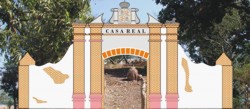 |
1st Capital of Abra |
|
|
|
|
|
 |
1st Capital of Abra |
|
|
|
|
|
|
Transcript of selected manuscripts In the course of doing the research behind this monograph, I had the privilege of consulting more than 500 manuscripts in the Philippine National Archives. The curators were kind enough to allow me to digitally photograph them and so I came to amass a very significant library of resources in the archives of my hard disk, to be precise a collection of 447 manuscript photos not including Xerox copies of maps and plans. I transcribed to text files about 60% of them, those I considered to be most relevant for the study and for its possible future expansion. In my dream, this study on Casa Real, Bucay and Abra is a first step towards the restoration of the historical quarter in Bucay. What I include here is a selection of a selection. The collection in my possession is rather vast and many of the manuscripts are not directly relevant to the items under study. Therefore, in selecting the manuscripts for publication as an annex to the study I chose to be guided by the references made in the study’s footnotes. The whole digital collection in my possession is published in a companion compact disk for reference of the studious. To the best of my knowledge, the contents of the entire collection, transcribed or not, are heretofore still unpublished. Although it was my original intention, time constraints did not allow me to undertake a translation, a task I will probably do at some other occasion. The transcription was done to reflect as close as possible the original Spanish, which being the Spanish of the 19th century bureaucrat for the most part, and in a remote area of the empire, is of a peculiar kind. The handwritten text is peppered with abbreviations of all kinds, at times so embellished they border on the iconic, and the escribanos or clerks did not have the command of language of the educated. The manuscripts then may betray a lower than standard syntax and an abundance of misspellings, consistently repeated. Diacritical marks are haphazardly applied if at all. I did not endeavor to ‘translate’ them to a more modern correct Spanish but decided to keep all, abbreviations, misspellings and other peculiarities, to convey the immediate literary ambiance of the rural bureaucrat in the Northern Cordillera in a new province and town that was created practically from zero, an ambiance achieved in part by an understandable shortage of well-trained clerks. Not all the documents in the collection are in the best of shape. All of them exhibit the implacable wear of time, weather, and cellulose oxidation by exposure to air through more than 150 years, making them very brittle on the edges that became darkened with some loss of text. Some are corroded by the chemical in the clerk’s ink, even by bugs, with the effect that the affected text, albeit partially, is irretrievably lost. This condition is reflected in the transcription with an occasional author’s note in italics within parenthesis. The manuscripts are arranged not
chronologically but by themes, in a sequence that follows the development
of the study. I refrained from directly annotating the text, leaving the
curious to develop his own reading. Indeed, one way to read the study is
as an annotation of manuscripts existing in the Philippine National Archives
on the Casa Real de Bucay.
|
||